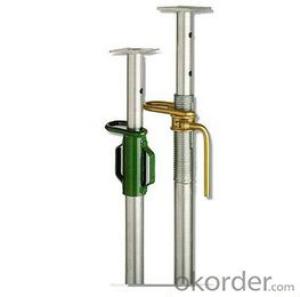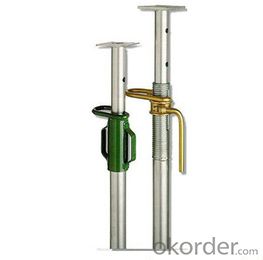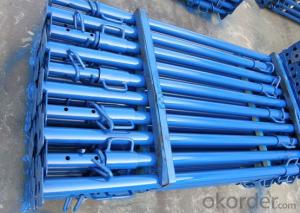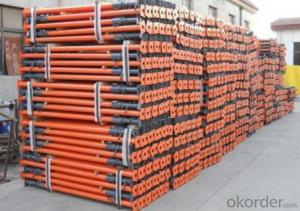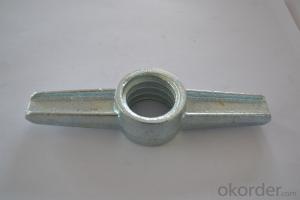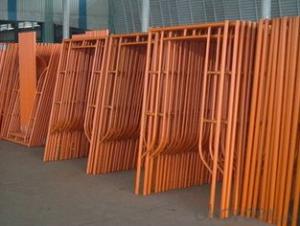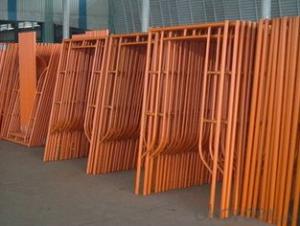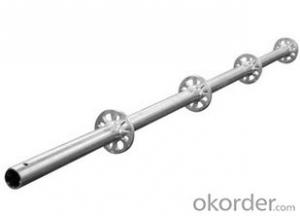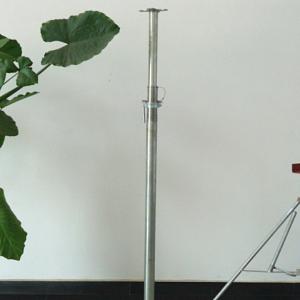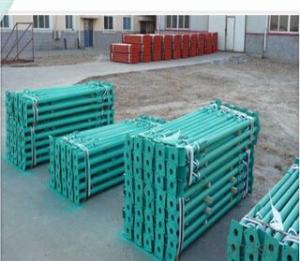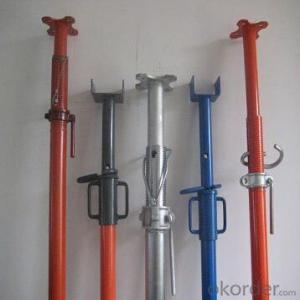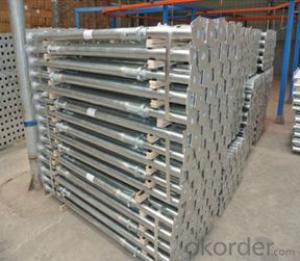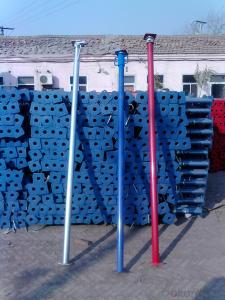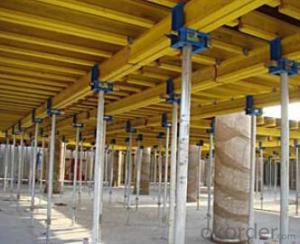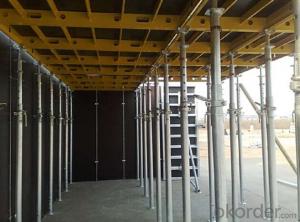adjustable scaffolding galvanized scaffolding steel props
- Loading Port:
- China Main Port
- Payment Terms:
- TT OR LC
- Min Order Qty:
- -
- Supply Capability:
- -
OKorder Service Pledge
OKorder Financial Service
You Might Also Like
Quick Details
| Type: | Scaffolding Part Type: | Feature: | |||
| Mode: | Diameter: | Weight: | |||
| Package: | Usage: | Delivery Time: | |||
| Surface Treatment: |
Packaging & Delivery
| Packaging Detail: | Steel pallets,Customized Package. |
| Delivery Detail: | About 10-25 days on receipt of your payment. |
Specifications
galvanized steel props
1.made of steel q235
2. length range:1.6-5m
3.1.6/1.8/2.0/2.2mm thickness
adjustable scaffolding galvanized scaffolding steel props
(Shoring Scaffolding Props, Steel Scaffolding Props)
1. Description of Steel Scaffolding Props
Scaffolding Prop
1.Adjustable steel scaffolding prop is vertical tubular type scaffold for supporting slab and decking beams.
2.The length of shoring prop can be adjust to any length within its range. AC steel prop have many size you can choose.
3.The steel prop's plate can be a base plate or u head or T head, as you required; the tread can be open thread or others.
We also can provide tripod and Forkhead to make your steel props system more steady and safe.
4.The surface of AC steel prop is high protected painted, color is dard red, but you also can choose other surface finishing.
2. Important information of AC Shoring Scaffolding Props
| Name | Scaffolding Prop |
| Type | Middle East type, Spanish type, Italian type |
| Brand | AC brand |
| Material | Q235 carbon steel |
| Dia(inner tube/outer tube) | 40mm/48mm, 48mm/56mm, 48mm/60mm |
| Tube thickness | 1.6mm/1.8mm/2.0mm/2.2mm/3.0mm |
| Adjustable length | 1600-2900mm, 1800-3200mm, 2000-3500mm, 2200-4000mm, other size also available |
| T head specification | 600*50.76*50.76*4mm or other size as you require |
| Surface treatment | Powder coated; painted |
| Color | Regular color is red, other color available |
| Welding technique | CO2 arc welding |
| Certification | SGS,BV,EN12810,ISO9001 |
| MOQ | 100pcs |
| Supply capacity | 500 tons per day |
- Q: What are the different locking mechanisms available for steel props?
- Different locking mechanisms are available for steel props, depending on the project's specific needs and requirements. Some commonly used mechanisms for steel props include: 1. Pin and chain: This mechanism is cost-effective and straightforward. It involves inserting a pin through holes on the outer tube of the prop and attaching a chain to prevent the pin from getting lost. It allows for easy and quick adjustment of the prop height. 2. Collar and pin: In this mechanism, a collar is placed around the outer tube of the prop. A pin is then inserted through holes on both the collar and the outer tube to secure the desired height. It offers a more secure locking system compared to the pin and chain method. 3. Twist-lock: This locking mechanism features a threaded collar on the outer tube of the prop. By twisting the collar, it engages with the inner tube and locks it in place. It provides rapid and precise height adjustment with a secure locking system. 4. Quick-release: This mechanism allows for swift installation and removal of the prop. It typically involves a lever or handle that, when engaged, secures the prop, and when released, allows for easy removal. Quick-release mechanisms are ideal for applications requiring frequent adjustments. 5. Prop clamps: These mechanisms involve clamps or brackets that securely hold the prop in place. They are commonly used in heavy-duty applications that require a high load-bearing capacity. Prop clamps offer a strong and secure locking system capable of withstanding substantial forces. When selecting a locking mechanism for steel props, it is crucial to consider the project's specific requirements, such as load capacity, ease of adjustment, and installation speed. Consulting with a structural engineer or construction professional can help determine the most suitable locking mechanism for a particular application.
- Q: Can steel props be used in warehouse construction?
- Warehouse construction can utilize steel props. These props, also known as adjustable steel props or scaffolding props, are commonly employed in construction endeavors to uphold vertical loads. They serve as temporary support during the construction process, particularly for formwork and scaffolding. In the context of warehouse construction, steel props can be employed to uphold hefty loads like roof beams, columns, and walls. They prove particularly useful in situations where supplementary support is necessary to guarantee the stability of the structure. Steel props can be conveniently adjusted to the desired height and can be used in various configurations to cater to the specific demands of the warehouse construction project. Furthermore, steel props present numerous advantages over alternative support systems. They possess the attributes of being lightweight, durable, and capable of enduring substantial loads. Additionally, they are versatile and can be effortlessly installed and disassembled, rendering them a cost-effective solution for provisional support in warehouse construction. Ultimately, steel props constitute a dependable and efficient choice for sustaining heavy loads in warehouse construction. Nonetheless, it is imperative to consult with a structural engineer or construction professional to ensure the proper and safe utilization of the props, in accordance with the project's distinct requirements.
- Q: Can steel props be used for supporting precast concrete elements?
- Yes, steel props can be used for supporting precast concrete elements. Steel props are commonly used in construction to provide temporary support during the installation and curing process of precast concrete elements. They offer stability, adjustability, and strength, making them suitable for holding the weight of these elements until they are fully set and able to bear their own weight.
- Q: Can steel props be used in high-rise construction?
- High-rise construction can indeed utilize steel props. These props, referred to as adjustable steel props or telescopic steel props, are frequently employed in construction for the purpose of providing temporary support to structures during renovation or construction work. Their design allows them to endure heavy loads and be adjusted to various heights, rendering them suitable for high-rise construction projects. By supplying stability and support to both vertical and horizontal loads, steel props guarantee the safety and structural integrity of the building throughout the construction process. Moreover, steel props offer versatility as they can be easily installed, dismantled, and repositioned as needed. Consequently, they have become a popular choice in high-rise construction due to their flexibility and adaptability.
- Q: How do you secure a steel prop in place?
- To secure a steel prop in place, you can follow these steps: 1. Position the steel prop: Place the steel prop in the desired location where it will provide support. 2. Adjust the prop height: Extend or retract the prop's telescopic sections to achieve the required height. 3. Tighten the locking mechanism: Once the prop is at the desired height, lock the telescopic sections in place using the prop's locking mechanism. This will prevent the prop from collapsing or shifting. 4. Secure the base: Ensure the prop's base is placed on a stable and level surface. If necessary, use shims or wedges to stabilize the base. 5. Provide additional support: Depending on the application, you may need to secure the prop further by attaching it to adjacent structures, using braces, or tying it off to ensure stability and prevent accidental movement. 6. Regularly inspect and maintain: Periodically check the prop's condition, especially during extended use, and tighten or adjust as needed to maintain its security. By following these steps, you can effectively secure a steel prop in place, providing reliable support and ensuring safety.
- Q: Can steel props be used for temporary support in solar power plant construction?
- Yes, steel props can be used for temporary support in solar power plant construction. Steel props are strong and durable, making them suitable for providing temporary support during the construction phase of a solar power plant. They can be easily adjusted and secured in place, ensuring stability and safety during the construction process.
- Q: Are steel props adjustable in angle?
- No, steel props are not adjustable in angle. They are designed to provide vertical support and stability, not to be adjusted or set at different angles.
- Q: How do you ensure stability when using steel props on uneven surfaces?
- To ensure stability when using steel props on uneven surfaces, there are several precautionary measures that can be taken. Firstly, it is of utmost importance to thoroughly assess the ground conditions before placing the steel props. It is essential to identify any unevenness or irregularities in the surface and make the necessary adjustments to level it out as much as possible. This may involve the removal of debris or filling in gaps with compacted soil or gravel. Secondly, it is worth considering the use of adjustable props that have the capability to adapt to uneven surfaces. These props typically have telescopic sections that can be extended or retracted to meet height requirements and compensate for any irregularities. By appropriately adjusting the props, a stable and secure setup can be achieved. Furthermore, it is advisable to utilize a base plate or a suitable load-bearing platform beneath the steel props. This aids in distributing the load evenly and provides a larger surface area, thereby reducing the risk of sinking or tilting. It is important to ensure that the base plate or platform is level and securely positioned, taking into account the weight and size of the props being utilized. Additionally, when setting up steel props on uneven surfaces, it is essential to provide sufficient bracing and support. This can be accomplished through the use of diagonal struts or cross braces to reinforce the structure and prevent lateral movement. Such measures help maintain stability and prevent the possibility of collapse or displacement. Moreover, it is crucial to regularly monitor and inspect the props during use. Regular checks should be performed to ensure that the props remain secure and stable, with adjustments made as necessary. Prompt attention and rectification should be given to any signs of instability or movement to guarantee the safety of both the structure and the personnel working in the vicinity. Lastly, seeking the guidance and advice of a professional engineer or expert is always wise when working with steel props on uneven surfaces. They can provide specific guidance and recommendations tailored to the requirements of your project, ensuring the maintenance of stability and the minimization of potential risks.
- Q: How do you ensure the stability of a steel prop on soft ground?
- To ensure the stability of a steel prop on soft ground, there are several measures that can be taken: 1. Assess the ground conditions: Before installing the steel prop, it is essential to assess the ground conditions thoroughly. This can be done by evaluating the soil type, moisture content, and any potential hazards such as underground utilities or weak spots. 2. Use proper foundations: To provide stability, it is crucial to use the appropriate type of foundation for the steel prop. This may include using concrete footings or steel plates to distribute the load evenly across the soft ground. The size and depth of the foundation will depend on the specific requirements of the project and the weight-bearing capacity of the ground. 3. Increase the surface area: To mitigate the risk of sinking or tilting, increasing the surface area in contact with the ground can help distribute the load more effectively. This can be achieved by using larger base plates or adding additional supports, such as timber planks or steel beams, to spread the load. 4. Install additional bracing: In some cases, additional bracing may be necessary to provide lateral support and prevent the steel prop from shifting or tilting. This can be done by installing diagonal bracing or tie-backs to anchor the prop against external forces. 5. Regular monitoring and maintenance: Once the steel prop is in place, it is essential to regularly monitor its stability, especially if there are any changes in ground conditions or load-bearing requirements. This may involve periodic inspections, adjusting the support as needed, and ensuring proper maintenance to prevent any deterioration over time. Overall, ensuring the stability of a steel prop on soft ground requires a combination of proper assessment, appropriate foundations, increased surface area, additional bracing, and regular monitoring. By implementing these measures, the risk of instability can be minimized, ensuring the safety and effectiveness of the steel prop.
- Q: What is the difference between the calculation of the axial force of concrete and steel support?
- Axial force calculation is the same. But there are differences in the specific design calculations.
Send your message to us
adjustable scaffolding galvanized scaffolding steel props
- Loading Port:
- China Main Port
- Payment Terms:
- TT OR LC
- Min Order Qty:
- -
- Supply Capability:
- -
OKorder Service Pledge
OKorder Financial Service
Similar products
Hot products
Hot Searches
Related keywords
